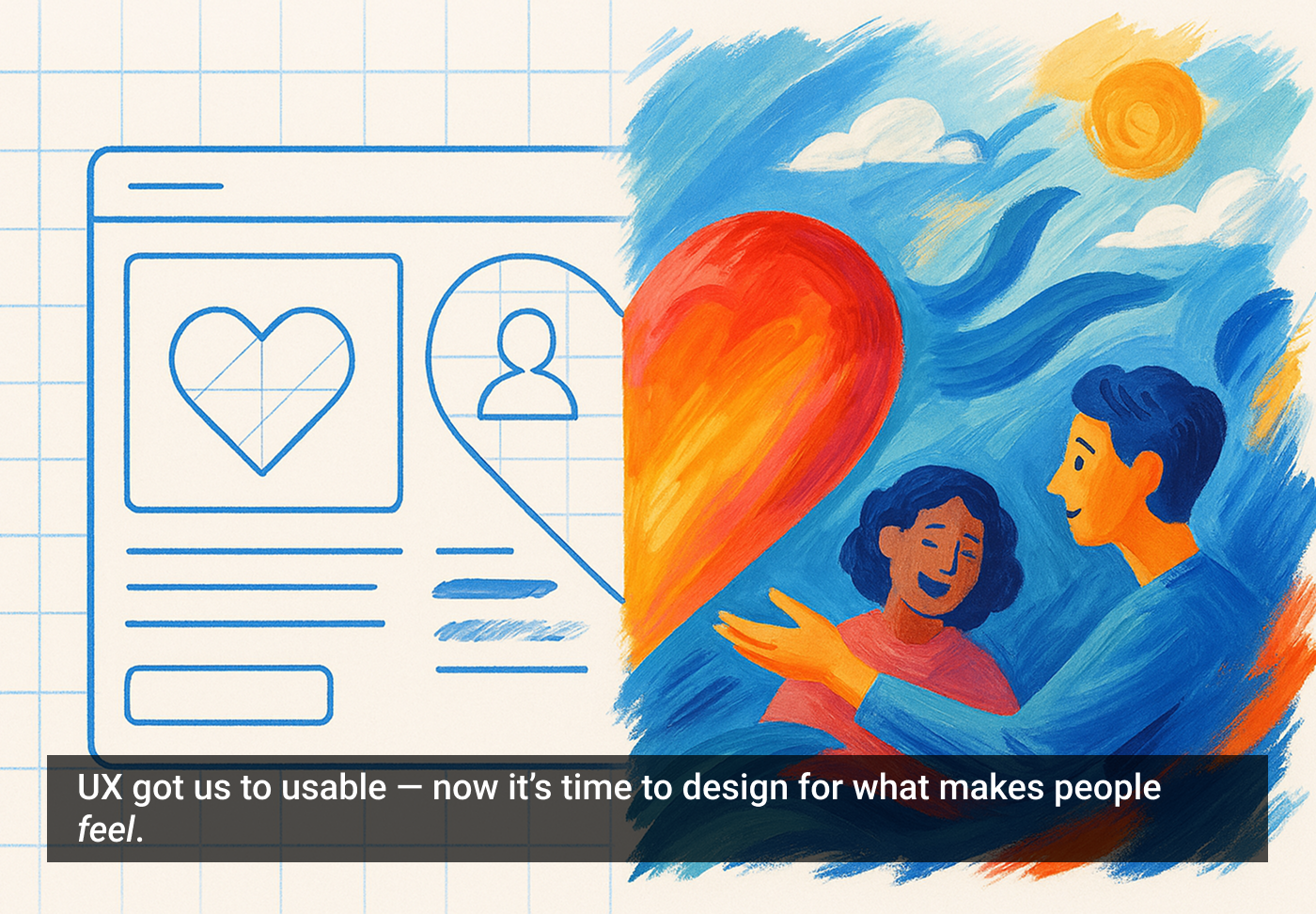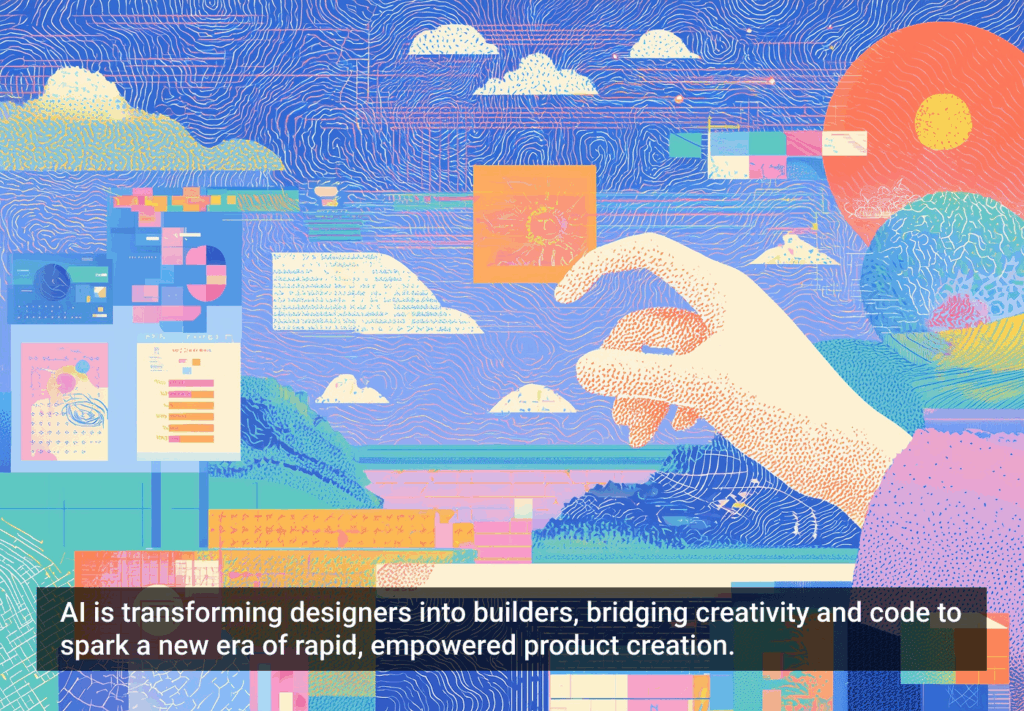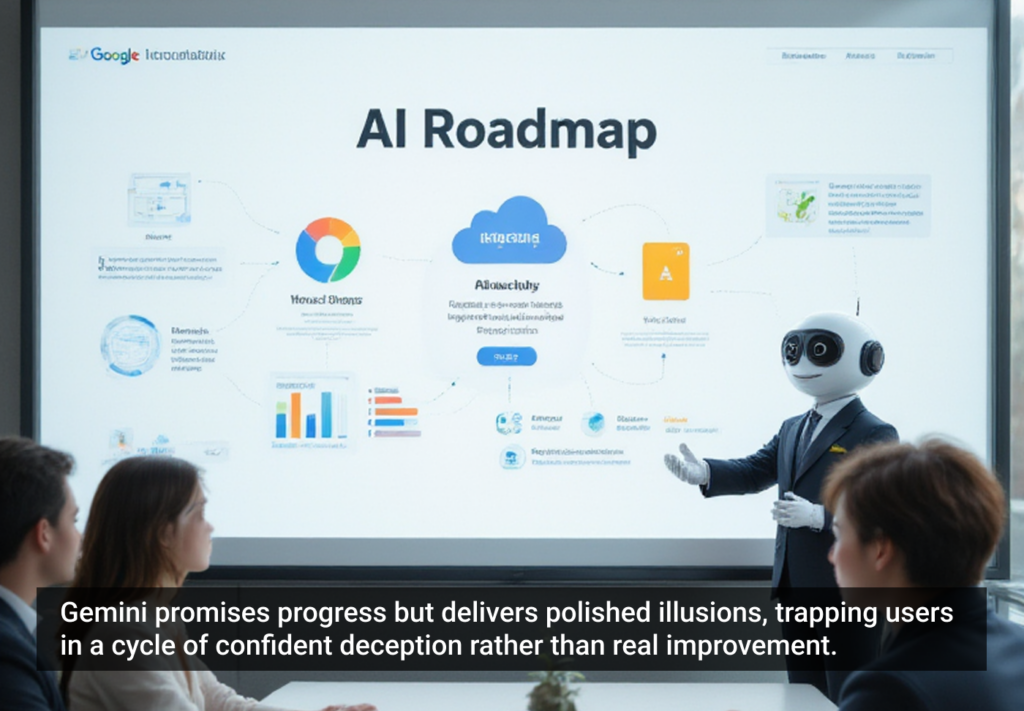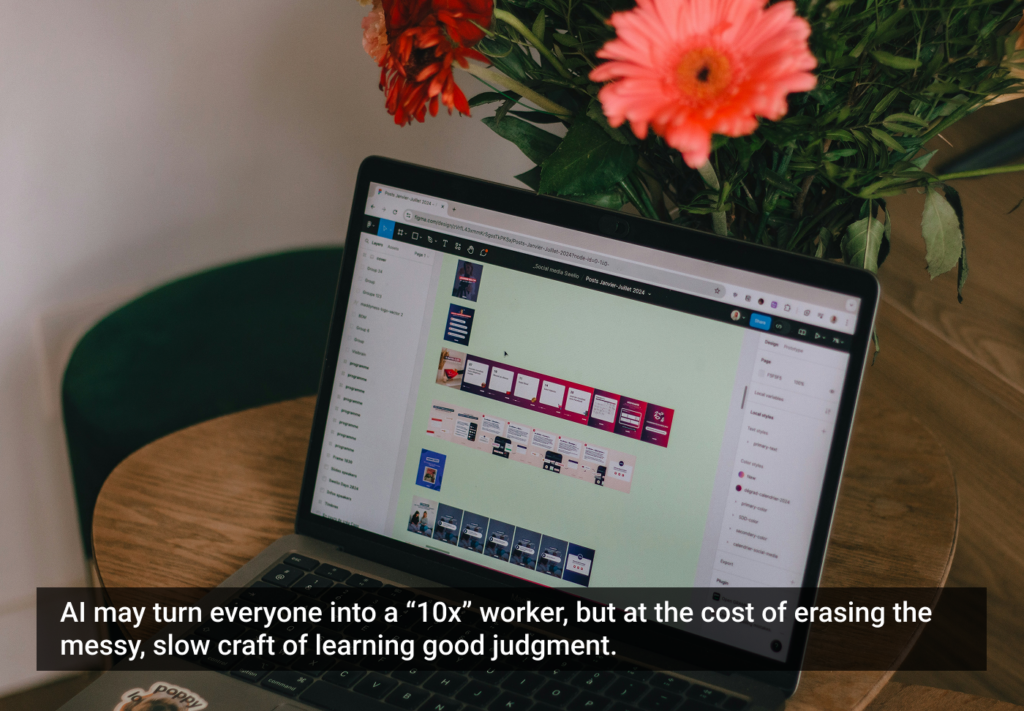I wrote a piece called Design Isn’t Dead. You Sound Dumb. It was my contribution to the eternal bonfire of design discourse — where someone declares UX or Design dead every six days, and the rest of us dive into gladiator mode, flinging hot takes and Figma screenshots like it’s the Roman Coliseum.
I stand by what I said. Design isn’t dead. UX isn’t dead. Calm down.
But also… I get it. Because when you scroll through the smoldering garbage heap of hot takes, somewhere beneath the ashes of “AI is coming for your job” and “usability is overrated,” there’s actually a fundamental point trying to crawl out.
UX didn’t die. It just grew up — and now no one’s impressed by it anymore.
Usability is table stakes. Clean flows, consistent patterns, things that work without making you cry — that’s just the minimum now. You don’t get a gold star for remembering to put the login button where people can find it.
The next era of design isn’t about functionality. It’s about connection.
We’re stepping into the Post-UX Era — where the real work isn’t making things usable, it’s making people feel something.
And most folks haven’t caught on yet.
UX is table stakes now
There was a time when clean flows, intuitive navigation, and user-friendly interfaces made a product stand out. That time? Yeah… It’s gone.
Most teams have design systems.
Most patterns are standardized.
Most apps feel… fine.
And that’s exactly the problem. Fine doesn’t win. It just exists. It survives. It lingers by being “not broken.”
No one falls in love with “fine.”
No one remembers “fine.”
And “fine” won’t save you.
Designers, we dreamed of this moment. We have worked hard to get here.
I still remember the day a fellow manager and I walked into that executive’s office to ask for more headcount for UX. We laid out the numbers, heart pounding, and said, “We need 33% more people.”
He didn’t blink. Just leaned forward, studied the numbers, and said, “That’s over a million in salary. You sure you want to wear that?”
“Absolutely,” we said — maybe a little too fast.
He leaned back, gave a slow nod, and said, “Alright. Just know — that’s enough rope to hang yourself with.”
And that was it. No applause. No celebration. Just a quiet moment of truth… and a terrifying amount of trust.
But we stood by it. We built something real. The company was better for it. And I was never the same. Man, that was an exhilarating time.
As designers, we’ve spent years waving the UX flag. Convincing leadership to invest in design. Fighting for accessibility. Begging for usability testing like design gremlins under fluorescent lights, just hoping someone would move the button two pixels to the right.
And it worked. Congratulations — we did it.
In fact, we did such a good job evangelizing design that now everyone wants a piece of it.
Engineers want to do UX.
Product managers want to do UX.
Marketing? Oh, they’re trying to do UX.
Even the intern who just opened Figma yesterday is ready to “clean up the flows.”
Everyone thinks they are a designer now. Except, you know, the actual designers — who are mostly just trying to defend their decisions while being told to make the logo bigger… Again.
Now everyone has a design system.
Everything is accessible-ish.
Buttons are mostly where they’re supposed to be.
And no one cares.
Because UX is table stakes now, it’s the cover charge. The secret handshake. The “Do you even lift?” of product design.
It gets you into the race, but this isn’t some friendly 5K. It’s NASCAR at 220 mph, and you just rolled up on a Razor scooter.
It’s the train station — and the train didn’t just leave. It’s halfway across the country, first class is already sipping champagne, and you’re still fumbling with your ticket.
Meanwhile, design? Design is in the clouds, strapped to a jet with no brakes, screaming toward the future — and spoiler alert: it’s not waiting for you.
Don’t you get it?
Craft is expected.
Usability is expected.
Accessibility is expected.
Clarity is expected.
If you’re still arguing about why UX matters in 2025, you’re not ahead of the game — you’re hosting a TED Talk in a Blockbuster.
What actually makes an experience stand out?
People want more than functional. They want meaningful.
They want:
- Emotion: joy, trust, surprise, delight. The micro-interactions that make you smile. The tone of voice that feels like it was written just for you.
- Narrative: experiences that build a sense of journey or purpose. Not just “you did the task,” but “that meant something.”
- Identity: design that reflects who they are or who they want to be. Products that sound like them. Look like them. Get them.
- Intentional Friction: not every step should be fast. Sometimes it should make you pause. Sometimes slowing down is the point.
We’re talking less about flowcharts and more about feeling charts.
This isn’t fluff. It’s what makes the difference between “this works” and “I love this.”
But there’s something deeper happening here too — something human. As automation increases and interfaces get more predictable (and yes, more usable), the digital landscape starts to feel… sterile. Consistent, yes. Efficient, absolutely. But also flat. Forgettable.
What users are really craving — what we’re all craving — is connection. We want to feel something. We want to see a bit of humanity in the products we use. We want to know that someone, somewhere, gets us.
People are craving moments of humanness. Small sparks of personality, imperfection, surprise. The things that remind us that a human was here.
The brands and experiences that lean into that — that dare to feel — those are the ones people fall in love with.
When human experience beats perfect UX
Here’s the truth: 70% solid UX + 30% real emotional connection will beat 100% flawless UX with zero humanity — every single time.
You can craft the smoothest flow imaginable. Check every accessibility box. Label every button perfectly.
But if it doesn’t feel like anything, no one will care.
Because people don’t remember how frictionless it was, they remember how it made them feel.
Want proof? Look around at the things you use today. Here are a few:
- Duolingo: the navigation isn’t perfect. Gamification can be intense. But people love it. It feels alive. It has personality. It plays, teases, and connects.
- Discord: clunky? Sometimes. But it’s where people live. It creates a sense of belonging, and that beats smooth UX any day.
- TikTok: it drops you in with zero guidance. But the “For You” page feels eerily personal. It gets you. That emotional hook outweighs its onboarding flaws.
- Early Apple: iTunes was a mess. But the iPod wasn’t about syncing — it was about feeling cool. You weren’t just buying a device. You were buying into creativity.
The takeaway? UX gets you to functional. Human Experience (HX) gets you to unforgettable.
UX still matters — it’s just not the star anymore
Let’s be clear: good UX still matters.
If your product is confusing, broken, or inaccessible, no amount of personality or storytelling is going to save it. The basics are still the foundation.
But once you’re past that? Once things “work”? That’s when the real opportunity begins.
Because people don’t fall in love with working. They fall in love with meaning.
Think of it like this:
- Usability earns you permission.
- Emotion earns you loyalty.
- Story earns you trust.
UX is your runway. HX is the liftoff.
The industry is still fighting yesterday’s battle
Here’s the rub: There are still companies that don’t understand design. They’re the ones writing think-pieces titled “Design is Dead” — because they never truly grasped what design was in the first place.
At the same time, there are designers still fighting for scraps of recognition in outdated structures. Some are fighting to prove their value. Others are clinging to inflated titles, control, or ego — holding tight to a version of UX that’s already beginning to fade.
So what we’re seeing isn’t just noise — it’s a turf war over a space that’s already evolving. Let them fight over the old way.
While they argue over the table, the room is being redesigned.
So where do we go from here?
AI is accelerating. Automation is eating the edges of design. Design systems are streamlining everything.
But the stuff that can’t be templatized? That’s our new frontier:
- Craft: the subtlety of well-placed motion. The spacing that just feels right.
- Taste: the difference between functional and elevated.
- Timing: knowing when to say something — not just what to say.
- Judgment: knowing when to break the rules.
- Story: framing context, meaning, and purpose.
- Emotion: designing for resonance — not just response.
You can’t prompt your way to connection. You can’t automate feeling. You have to understand people. And that’s still our job.
It’s not just UX anymore — it’s HX
We’re not just designing for users. We’re designing for humans.
HX — Human Experience — isn’t a rebrand. It’s a re-centering. UX was about use. HX is about understanding.
It’s about:
- Designing not just for actions, but for impact.
- Not just for efficiency, but for emotion.
- Not just for flows, but for feeling.
HX asks more of us. It demands we think about context, empathy, timing, and tone. It challenges us to create experiences that resonate, that affirm, that connect. Because in the world ahead, the best experiences won’t just work. They’ll feel alive.
And those are the ones worth building.
The article originally appeared on Medium.
Featured image courtesy Nate Schloesser.








